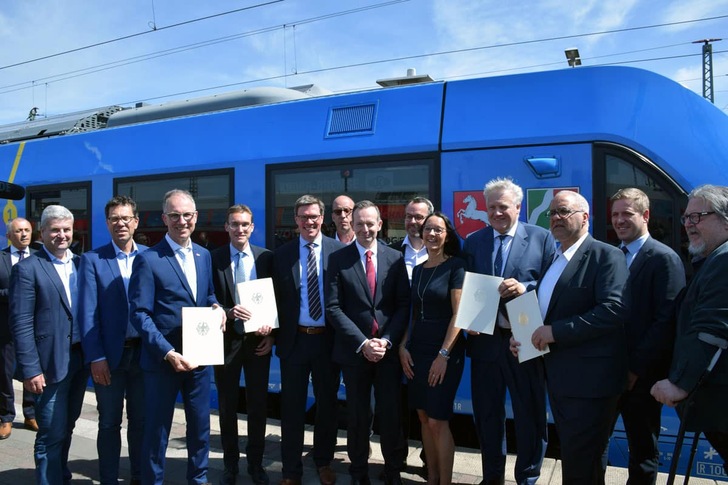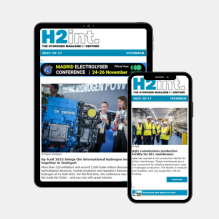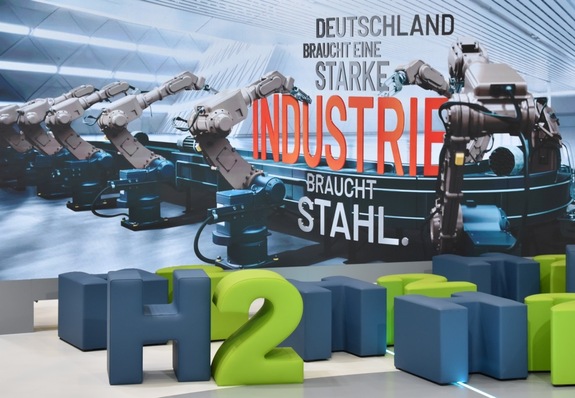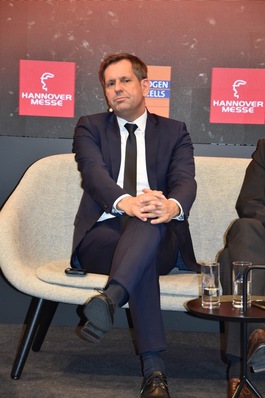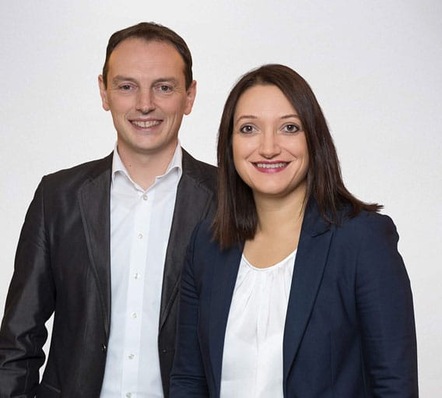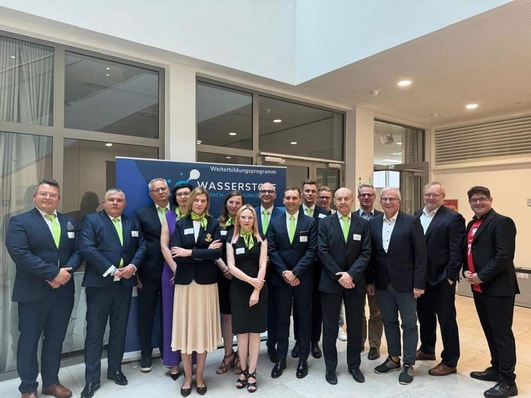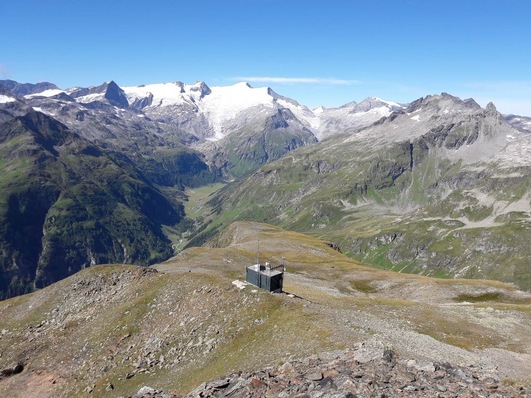The largest project overseen by the district of Düren is the full-blown conversion of train and bus fleets to green hydrogen. The sustainable fuel is to be produced locally from early 2025 via a 9-megawatt PEM electrolyzer facility. In addition, an ever-increasing number of hydrogen projects are appearing at exceptional speed which will help the area achieve its goal of becoming net-zero by 2035 (see p. 26). These schemes also act as a good example to others. Industrial-scale production plants for green hydrogen, like those being developed near the town of Jülich, are still few and far between. According to the International Renewable Energy Agency, only 4 percent of the hydrogen manufactured globally in 2021 was green.
“We need pioneers who lead the way,” said German transportation minister Volker Wissing when handing over funding letters for grants worth EUR 81.6 million in May 2023. The money is being channeled into a range of projects including the building of electrolyzers, the purchase of 17 hydrogen railcars which will replace the existing diesel railcars by 2026, and the installation of a hydrogen train refueling facility in the district. In another project, the district is converting the fleet of bus company Rurtalbus. So far, a total of five hydrogen-powered buses are now circulating on the area’s roads. A further 20 buses are expected to join them by the end of the coming year.
In Wissing’s view, evidence of Düren’s pioneering attitude can be seen particularly in the fact that, rather than just running hydrogen-powered trains, carbon-neutral green hydrogen production will be introduced as well. “Hydrogen projects are great. But where is the green hydrogen going to come from? The smart approach is to tackle this question head-on and say: It’s best if we make it ourselves.”
Ahead of the grants
That a flagship project of this kind is now taking shape in Düren is thanks to the head of the district authority, Wolfgang Spelthahn (see fig. 3), who incorporated the use of hydrogen very early on in the planning process. At the time when he expressed the ambition of turning Düren into a model region for hydrogen, there was still no sign of the EUR 14.8 billion in funding that was later earmarked in the 2020 structural enhancement law which outlined the plans for restructuring in the Rhineland and signaled the phaseout of power generation using brown coal. “We recognized the benefits of green hydrogen early and took a long view to invest in the future. This enabled us to gain a considerable advantage,” says Spelthahn.
In 2020, the German government decided to phase out brown coal by 2038 and approved billions of euros in grants for this purpose. A year later, the then North Rhine-Westphalia economy minister Andreas Pinkwart paid a visit to Düren and described the Rhineland as the “greatest climate action project in the world.” The statement remains true today: The Rhineland is the largest mining area for brown coal in Europe, making it a major emitter of greenhouse gases such as carbon dioxide.
What FDP politician Pinkwart could not know is that the subsequent conservative-green coalition would, a year later, further step up the pace of restructuring significantly. Consequently, the date for extracting the last brown coal from Germany’s western minefields was brought forward from 2038 to 2030.
This move drew much criticism, for example from industry quarters. Industry representatives denounced the phaseout as too rapid since new technology would be too slow to set up. As a result, the Cologne Chamber of Industry and Commerce refused to sign the recast regional agreement in early summer. Behind the refusal was this simple calculation: To compensate for the energy no longer produced due to the withdrawal from brown coal, the region would have to build an additional 1,500 wind turbines. According to the Cologne chamber, it currently takes too long to construct a wind turbine, with the period from initial proposal to commissioning lasting seven years. The conclusion: It’s not just the energy-intensive industries situated in and around the Rhineland that have concerns about security of supply.
Visible progress
Against this backdrop, Düren’s hydrogen initiatives set it apart from other districts. The majority of the projects that have managed to get underway in the Rhineland, despite everything, are located there. The solar park, with a capacity of up to 9.2 megawatts, which will supply a large part of the green energy for electrolysis, is already installed. In all, 18,200 solar modules will generate enough power to supply almost 3,000 homes. The amount of carbon dioxide saved each year will be 4,604 metric tons.
However, in the long term, the power generated will not be sufficient to produce the targeted 162 kilograms of hydrogen per hour at the expected 4,000 to 5,000 full-load hours a year. For this reason the district is planning to use additional renewable sources. The electrolyzer is being built and operated by HyDN. The company has involvement from both the holding company Beteiligungsgesellschaft Kreis Düren and industrial gases enterprise Messer Industriegase in Bad Soden.
Hydrogen capability on show
A key aim for the district is to show people what hydrogen can do. At the end of 2022, a hydrogen-powered rapid response vehicle joined the fleet of Düren’s ambulance service. The Hyundai Nexo is used by service leaders to reach their assignments and carries essential equipment on board for assisting accident victims.
It is also hoped that the first hydrogen ambulance will enter service before the year is out. The vehicle will be specially built in a collaboration involving several companies. “If we bring a hydrogen-powered ambulance onto the district’s streets, then the people will see that this type of power system works in everyday practice. That sends exactly the right signal to the public,” described Wolfgang Spelthahn at the signing of the letter of intent for the production of the hydrogen ambulance.
The advantages of hydrogen are obvious according to Spelthahn: Instead of long charging cycles for electric vehicles, hydrogen can be refueled in eight minutes. The range is higher than for a battery-driven ambulance. In short, the ambulance is available for longer and can be deployed more flexibly, especially as hydrogen refueling stations are being constructed in the area. The first station, located right next to the A4 autobahn, was opened in September 2022 and has been in regular operation since the summer in the Im Großen Tal industrial park in Düren.
The district’s focus on hydrogen is also plain to see in Düren’s welcome center which includes a hydrogen information center. From October 2023 this will feature a public exhibition with an interactive display about hydrogen. It will explain various aspects, starting with basic principles, extending along the value chains and concluding with end use.
Hydrogen fair boosts network
Düren’s annual hydrogen trade fair, which took place in August 2023 for the third time, carries an additional message: While one person alone can achieve a great deal, the energy transition with hydrogen as a key technology will only be successful if many people work together. The hydrogen fair in the Kulturmuschel exhibition space in Jülich brings together experts and offers local people the chance to acquire a wide range of information about the subject. New ideas, networks and collaborations are formed as a result. On the eve of the fair’s opening, the Hygo award is presented by the district. The hydrogen prize, with Young Researchers, Start Up Innovation and Hydrogen Champion categories, recognizes those people who are driving forward the energy transition while at the same time focusing on hydrogen as the fuel of the future.
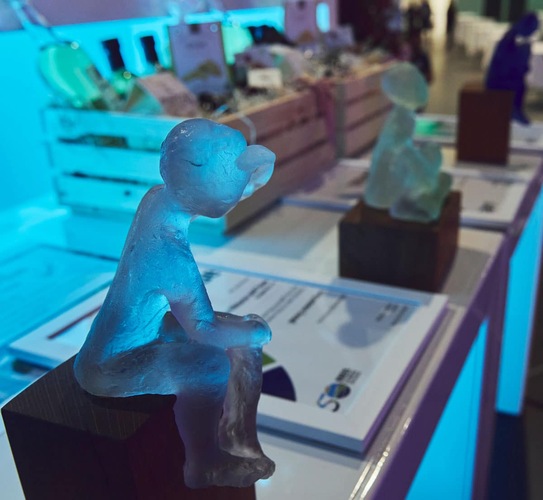
A key part of this exhibition from the very beginning has been the FZ Jülich research center. The scientific research that takes place here, for instance into electrolysis and fuel cells, has attracted worldwide attention for many years. The research center is among the main driving forces behind restructuring in the Rhineland. This is particularly evident in its newest institute.
The Institute for Sustainable Hydrogen Economy (INW) has been under construction for nearly two years at the Brainergy Park near Jülich, the latter being an industrial park designed with state-of-the-art supply infrastructure. Düren, which along with its partnering organizations is building its proton exchange membrane electrolyzer on the edge of the park, is one of the shareholders of the Brainergy Park. The INW conducts fundamental research into the storage and transportation of hydrogen. However, it is also at the center of a cluster where research findings will be put straight into practice.
The Helmholtz hydrogen cluster HC-H2 is the largest funded project within the Rhineland’s restructuring program with a grant sum of more than a billion euros. And it’s the biggest hydrogen infrastructure project in Germany, with the expectation that its staff numbers will top 500 employees. It is hoped it will act as a magnet, attracting to the area other companies that intend to explore hydrogen in the pursuit of net-zero.
“It is extremely helpful that the Düren district is located in a region that is so quick when it comes to deploying hydrogen,” says INW director Andreas Peschel. “It greatly furthers the hydrogen cause if the people, for example, see trains and ambulances running on hydrogen.”
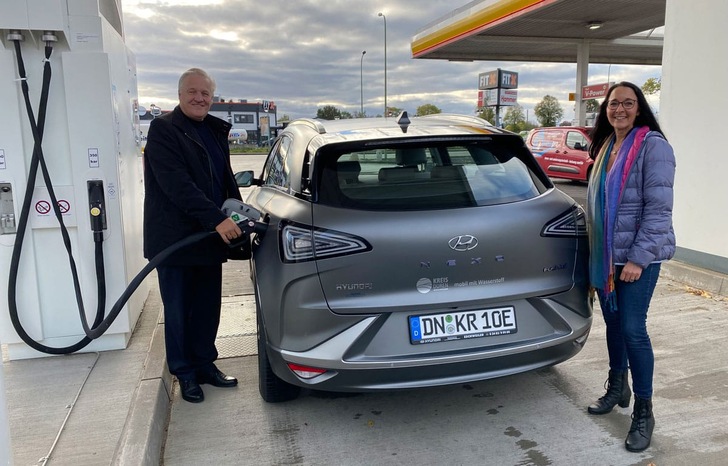
Authors: Guido Jansen, Forschungszentrum Jülich GmbH, Institute for Sustainable Hydrogen Economy (INW), g.jansen@fz-juelich.de,
Anne Schüssler, District of Düren, a.schuessler@kreis-dueren.de


